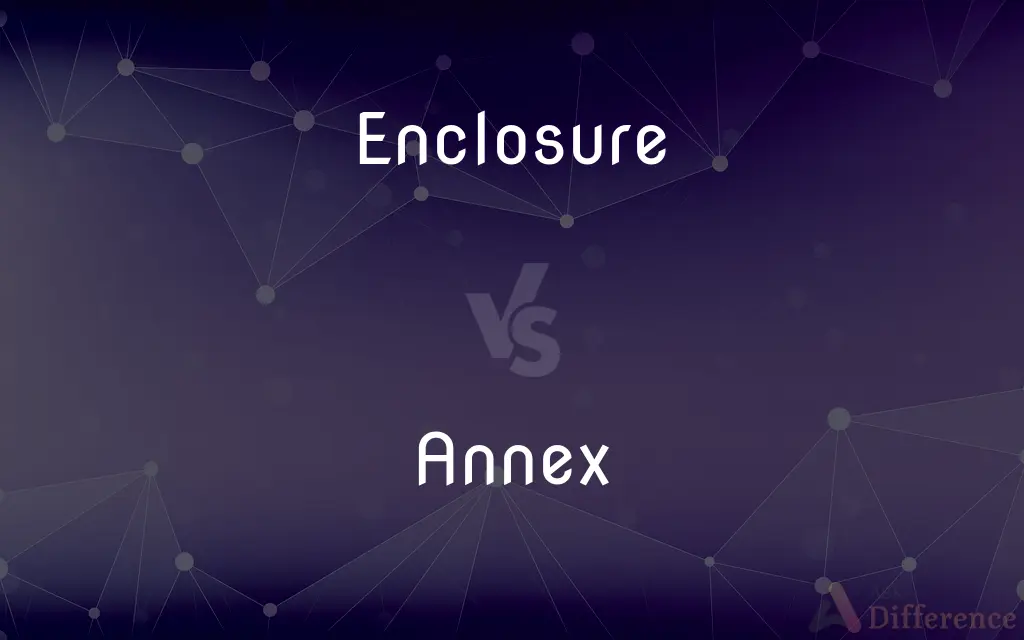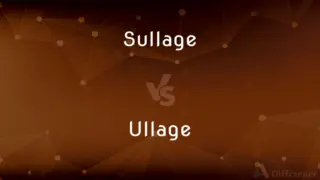Enclosure vs. Annex — What's the Difference?
By Fiza Rafique & Urooj Arif — Updated on April 27, 2024
An enclosure is a space surrounded and separated by barriers, often for security or privacy; an annex is a building or space added to an existing structure, enhancing its capacity or function.

Difference Between Enclosure and Annex
Table of Contents
ADVERTISEMENT
Key Differences
An enclosure is defined by its purpose of containing or isolating something within boundaries, such as fences or walls. Whereas, an annex refers to an addition or extension to a main building, usually to accommodate more space or specialized functions.
Enclosures are used across various contexts from wildlife preserves to fenced backyard areas focusing on separation and protection. On the other hand, annexes are typically part of architectural designs, expanding living or working spaces in residential or commercial properties.
The function of an enclosure often involves safety and restriction, ensuring that what is inside is kept separate from the outside environment. In contrast, an annex enhances the usability of a space, integrating seamlessly with the original structure to provide additional room or facilities.
Enclosures can be temporary or permanent structures, adaptable to needs such as construction sites or temporary exhibits. Annexes, however, are usually permanent expansions of existing buildings, requiring planning and construction that conforms to the original architecture.
The design of an enclosure emphasizes practicality and security, prioritizing materials and forms that fulfill specific containment roles. Conversely, the design of an annex focuses on aesthetic and functional continuity with the existing building, often reflecting similar architectural styles.
ADVERTISEMENT
Comparison Chart
Purpose
To contain or isolate within specific boundaries.
To add space or functionality to an existing structure.
Usage Contexts
Wildlife preserves, private gardens, construction sites.
Schools, hospitals, residential buildings.
Function Focus
Safety, security, and separation.
Expansion, integration, and enhanced utility.
Permanence
Can be either temporary or permanent.
Generally permanent.
Design Priorities
Practicality and security.
Aesthetic and functional continuity with the main structure.
Compare with Definitions
Enclosure
A structure or area enclosed by barriers, used to secure and separate the contents from the surrounding environment.
The zoo designed a new animal enclosure to mimic natural habitats.
Annex
Common in educational, residential, and commercial environments.
The apartment complex added an annex to accommodate more residents.
Enclosure
Can be crafted from various materials such as metal, wood, or concrete, depending on the purpose.
The garden enclosure was made of wooden fencing to keep deer out.
Annex
Integral to architectural expansion projects.
The school’s annex included new classrooms and a laboratory.
Enclosure
May involve legal or regulatory guidelines especially in public and environmental safety contexts.
The industrial enclosure was mandated by environmental protection laws.
Annex
Requires careful planning and construction to ensure integration with the main structure.
The annex to the historic courthouse was built with careful attention to match its early 20th-century architecture.
Enclosure
Used in both urban and natural settings.
Construction enclosures are common in urban areas to ensure safety.
Annex
A building or space added to an existing structure to provide additional capacity or functionality.
The museum’s new annex offered space for more exhibits.
Enclosure
Often related to protection and privacy.
The high enclosure around the compound ensured privacy for the residents.
Annex
Designed to complement the original building in style and purpose.
The office annex mirrored the design of the main building, maintaining a unified look.
Enclosure
'Enclosure' or 'Inclosure' is a term, used in English landownership, that refers to the appropriation of "waste" or "common land" enclosing it and by doing so depriving commoners of their ancient rights of access and privilege. Agreements to enclose land could be either through a "formal" or "informal" process.
Annex
Add as an extra or subordinate part, especially to a document
The first ten amendments were annexed to the Constitution in 1791
Enclosure
The act of enclosing.
Annex
Add (territory) to one's own territory by appropriation
The left bank of the Rhine was annexed by France in 1797
Enclosure
The state of being enclosed.
Annex
A building joined to or associated with a main building, providing additional space or accommodation
The school's one-storey wooden annex
Enclosure
Something enclosed
A business letter with a supplemental enclosure.
Annex
An addition to a document
An annex to the report
Enclosure
Something that encloses.
Annex
To append or attach, especially to a larger or more significant thing.
Enclosure
(countable) Something enclosed, i.e. inserted into a letter or similar package.
There was an enclosure with the letter — a photo.
Annex
To incorporate (territory) into an existing political unit such as a country, state, county, or city.
Enclosure
(uncountable) The act of enclosing, i.e. the insertion or inclusion of an item in a letter or package.
The enclosure of a photo with your letter is appreciated.
Annex
To add or attach, as an attribute, condition, or consequence.
Enclosure
(countable) An area, domain, or amount of something partially or entirely enclosed by barriers.
He faced punishment for creating the fenced enclosure in a public park.
The glass enclosure holds the mercury vapor.
The winning horse was first into the unsaddling enclosure.
Annex
A building added on to a larger one or an auxiliary building situated near a main one.
Enclosure
(uncountable) The act of separating and surrounding an area, domain, or amount of something with a barrier.
The enclosure of public land is against the law.
The experiment requires the enclosure of mercury vapor in a glass tube.
At first, untrained horses resist enclosure.
Annex
An addition, such as an appendix, that is made to a record or other document.
Enclosure
The act of restricting access to ideas, works of art or technologies using patents or intellectual property laws.
Annex
An addition, an extension.
Enclosure
The post-feudal process of subdivision of common lands for individual ownership.
Strip-farming disappeared after enclosure.
Annex
An appendix to a book or document.
Enclosure
(religion) The area of a convent, monastery, etc where access is restricted to community members.
Annex
An addition or extension to a building.
Enclosure
Inclosure. See Inclosure.
Annex
An addition to the territory of a country or state, from a neighbouring country or state, normally by military force.
Enclosure
Artifact consisting of a space that has been enclosed for some purpose
Annex
To add something to another thing, especially territory; to incorporate.
The ancient city of Petra was annexed by Rome.
Enclosure
The act of enclosing something inside something else
Annex
To attach or connect, as a consequence, condition, etc.
To annex a penalty to a prohibition, or punishment to guilt
Enclosure
A naturally enclosed space
Annex
(intransitive) To join; to be united.
Enclosure
Something (usually a supporting document) that is enclosed in an envelope with a covering letter
Annex
To join or attach; usually to subjoin; to affix; to append; - followed by to.
Annex
To join or add, as a smaller thing to a greater.
He annexed a province to his kingdom.
Annex
To attach or connect, as a consequence, condition, etc.; as, to annex a penalty to a prohibition, or punishment to guilt.
Annex
To join; to be united.
Annex
Something annexed or appended; as, an additional stipulation to a writing, a subsidiary building to a main building; a wing.
Annex
An addition that extends a main building
Annex
Take illegally, as of territory;
The Israelis are annexing more and more territory on the West Bank
Annex
Take (territory) by conquest;
Hitler annexed Lithuania
Annex
Attach to
Common Curiosities
Can an annex also function as an enclosure?
Yes, an annex can function as an enclosure if it is designed to secure or separate an area within its additional space.
What are common materials used to build an enclosure?
Enclosures can be built from wood, metal, concrete, or synthetic materials, depending on security needs and environmental conditions.
What is the main difference between an enclosure and an annex?
An enclosure is primarily for containing or isolating within boundaries for security or privacy, while an annex is for adding space or functionality to an existing building.
What types of facilities commonly add annexes?
Schools, hospitals, and commercial buildings commonly add annexes to meet growing space requirements.
How do enclosures enhance security?
Enclosures enhance security by controlling access and preventing unauthorized entry into protected areas.
What legal considerations are there when building an annex?
Legal considerations for building an annex include zoning laws, building codes, and sometimes historical preservation standards.
Are enclosures only used outdoors?
No, enclosures can be used both indoors and outdoors depending on the purpose, such as indoor security cages or outdoor animal enclosures.
How does the addition of an annex impact the value of a property?
Generally, adding an annex can increase the value of a property by expanding its usable space and potential functionality.
What are some examples of temporary enclosures?
Temporary enclosures include construction site barriers, event fencing, and temporary animal pens.
Can an enclosure be considered an architectural feature?
Yes, enclosures can be designed as integral architectural features, especially in modern and security-focused designs.
Share Your Discovery

Previous Comparison
Sullage vs. Ullage
Next Comparison
Bootlegging vs. PiracyAuthor Spotlight
Written by
Fiza RafiqueFiza Rafique is a skilled content writer at AskDifference.com, where she meticulously refines and enhances written pieces. Drawing from her vast editorial expertise, Fiza ensures clarity, accuracy, and precision in every article. Passionate about language, she continually seeks to elevate the quality of content for readers worldwide.
Co-written by
Urooj ArifUrooj is a skilled content writer at Ask Difference, known for her exceptional ability to simplify complex topics into engaging and informative content. With a passion for research and a flair for clear, concise writing, she consistently delivers articles that resonate with our diverse audience.
















































